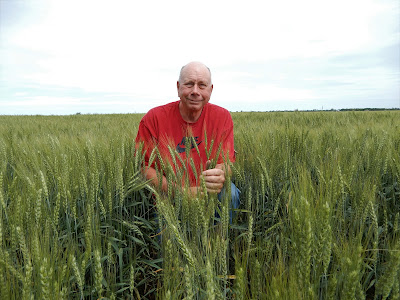Still, it's valuable to tally numbers from time to time. The finale of Wheat Harvest 2020 is one of those times. And we are DONE - as of about 8 PM, Tuesday, July 7. Thankfully, my husband is a numbers guy and makes yearly charts with yields at each field and other dizzying details.

2010: June 18
2011: June 10
2012: May 26 (an anomaly and the earliest harvest, by far, we've ever had)
2013: June 21
2014: June 17
2015: June 20
2016: June 15
2017: June 12
2018: June 12
2019: June 26
2020: June 16
 |
| through the combine windshield - June 16, 2020 |
The finish dates are all over the board in the past 10 years, too:
2010: June 252011: June 20
2012: June 9 (an anomaly)
2013: July 6
2014: July 7
2015: July 1
2016: July 13 (another saga of a harvest)
2017: June 28
2018: June 29
2019: July 22
2020: July7
We were blessed with a better-than-average harvest in 2020. We are especially grateful after last year, which was our worst harvest since I began blogging (and among the worst since Randy began farming back in the 1970s.)

2010: 37.2 bu/acre
2011: 36.7 bu/acre
2012: 45.5 bu/acre
2013: 52 bu/acre
2014: 24.5 bu/acre
2015: 50 bu/acre
2016: 48.5 bu/acre
2017: 50.84 bu/acre
2018: 39.2 bu/acre
2019: 23.6 bu/acre
2020: 49.5 bu/acre
Our high yield was 76.5 bushels per acre. Our low was 26. As Randy says, he's "exceptionally happy."





Here are a few other photos of the wheat crop as it grew:
October 22, 2019
Spring green ...
April 2, 2020
May 8, 2020

May 28, 2020

2020 has been a year to remember. Both Randy and I are presidents of our respective branches of the Kansas Master Farmer/Homemaker organization. We (read - me!) had to write a summer letter and in it, we acknowledged how much lives have changed with Covid-19. (This reflects our division of labor. He's the numbers guy. I take care of the words.)
Here's just a snippet of the letter:
Even as we’ve had to learn to watch church services online, attend meetings via Zoom and call ahead at farm supply stores because of locked doors, the work has churned on at our homes and ranches. I’m guessing most of us already made most meals at home, so we were ahead of the curve! We still had baby calves to work and the annual exodus to take cow-calf pairs to summer pasture. Spring planting still got done, and the corn and soybean plants seem to grow overnight these days. ...
As you watch another Kansas sunrise or sunset or see those sunflowers blooming along our ditches, we hope you’ll find the beauty in this spectacular life we live, even in the midst of a difficult time. Our ancestors faced adversity. They laid the groundwork for perseverance. It’s even bound up in our state motto: To the stars through difficulty. Here on the Stafford/Reno County line, we hope you are finding the stars and the beauty in each day.

 |
| Randy & his dad, Melvin, at harvest - undated (sorry!) |







Loved the stats! So much to take in, in this post and always with your writing, the need to be positive shines through. Do all your states have a motto?
ReplyDeleteGood luck with the clean and purge!
I think most states probably have mottos, though I would be hard-pressed to name them all. Thanks for the vote of confidence on the clean and purge. I've already made great progress, but there's definitely more to do.
Delete